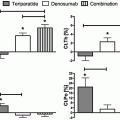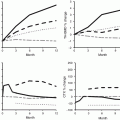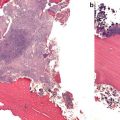© Springer International Publishing Switzerland 2016
Stuart Silverman and Bo Abrahamsen (eds.)The Duration and Safety of Osteoporosis Treatment10.1007/978-3-319-23639-1_2323. Conclusions
(1)
Division of Rheumatology, Cedars-Sinai Medical Center, UCLA School of Medicine and the OMC Clinical Research Center, 8641 Wilshire Blvd, suite 301, Beverly Hills, CA 90211, USA
(2)
Institute of Clinical Research, OPEN, University of Southern Denmark, JB Winslowsvej 9,3, Odense, DK-5000, Denmark
Keywords
OsteoporosisONJAtypical femoral fractureAntiresorptive medicationAnabolic medicationOsteoporosis medication safetyBisphosphonate holidaysThis is an exciting time in the world of osteoporosis treatment with an increasing opportunity to individualize osteoporosis therapies for our patients based on efficacy, safety, and convenience and potential for adherence. However, there are also new challenges within long-term efficacy and safety as we are moving toward the possibility of “treat-to-target” algorithms . Firstly, the algorithms are not yet agreed upon [1, 2]. Can the task be simplified so that clinicians can simply look for certain target BMD? This could perhaps be a BMD threshold where patients would have been too healthy to be candidates for the clinical trials that were proof of efficacy or one that was shown in trials to separate at least partly between those who would benefit from an extension of the treatment period and those who likely would not as in the alendronate FLEX study [3] or zoledronic acid HORIZON extension [4]. This could also be a ten-year fracture risk threshold such as FRAX [5] with the fracture risk threshold being derived from a given health care system’s willingness to treat.
Our first step is to “target-to-treat” patients. Our first target is patients with fragility fracture who are at high risk for further fracture of which only a minority are being treated [6–8]. The development of system-wide interventions such as fracture liaison services is slowly helping us to better identify patients at need of intervention due to increased fracture risk.
A patient with a fragility fracture has had a sentinel event which tells us that patient is at increased risk. But we also identify patients based on BMD and other clinical risk factors such as falls, medications, or conditions associated with osteoporosis.
We now recognize that bone strength is related to both bone quantity and bone quality. Newer measurement techniques such as trabecular bone score [9] or microindentation [10] as well as bone turnover markers may provide some insight into bone quality. Bone turnover markers may also provide insight into rate of predicted BMD loss and do in themselves add to BMD and clinical risk factors in predicting the risk of fractures [11].
There is increased recognition that osteoporosis is not perhaps best defined by DXA T score alone. We now recognize that osteoporosis is not only characterized by low bone density but also by microarchitectural deterioration of bone leading to decreased bone strength (NIH consensus conference [12]). Unfortunately payors sometimes determine eligibility for an osteoporosis medication based only on decreased BMD. A recent US working group paper by Siris has redefined osteoporosis not only based on BMD but on FRAX and/or prevalent fragility fracture [12].
We want to prevent further fracture in our patients, recognizing the costs and loss of quality of life. However, fracture prevention is not simply choosing the right medication. Some aspects of fracture prevention are not related to the skeleton at all, but focus on maintaining muscle strength and body balance, hence reducing the risk of fall-related fractures. Thus despite populations’ aging, the age-adjusted risk of hip fracture—the archetypal fall-related fracture—is decreasing in large parts of the world, probably less due to pharmaceutical intervention than to improvement in functional status, nutrition, and general health [13–15].
The recent few years have brought about new anabolic and antiresorptive drugs (see Chaps. 3 and 4), some of which are in widespread clinical use at the time of writing while others are in phase II and phase II trials. In Chap. 10, Bouxsein discusses how antiresorptive therapies work by reducing bone turnover and by mineralizing old bone. In contrast, in the simplest terms, anabolics (please see Chap. 3) work by a different mechanism by stimulating the formation of new, young bone, while antiresorptive agents (Chap. 2) improve the strength of bone by keeping older bone tissue in service for longer, hence increasing the mean age of bone [16] where anabolics do the opposite. This has practical implications in terms of concern over the ultimate toughness of older bone tissue and monitoring issues because older bone is more highly mineralized than young bone, producing a slight negative bias against anabolics when monitoring by methods where mineral alone is the unit of currency, such as DXA. Antiresorptive agents differ in their residence time in bone and reversibility (see Russell Chap. 2).
Osteoporosis medications have both short- and long-term adverse events (AEs) [17]. Long-term adverse events usually have a low incidence and increase with duration of use of therapy. There may be an inflection point for rare long-term AEs such as atypical femoral fracture (AFF) and osteonecrosis of the jaw (ONJ). Also, ONJ may be preventable in some cases with use of antibiotics and primary closure (see Sedghizadeh Chap. 12).
In patients at high risk of fractures due to osteoporosis, intervention with osteoporosis medications generally produces benefits that far outweigh what can be achieved by non-pharmaceutical means. On a group basis, these benefits strongly offset any known risks of side effects, though they can be devastating in the rare instances that they occur and it is hard for the patient and health provider to compare a real occurrence of ONJ or AFF with the less tangible benefit of having avoided major osteoporotic fractures. This is particularly challenging as all patients will not be at equal risk of these events, with the risk of ONJ, for example, far larger in patients with poor dental status or ill-fitting dentures who have an invasive dental procedure such as dental extraction and the risk of AFF being influenced by baseline characteristics such as race and femur geometry.
Although side effects such as ONJ and AFF are rare, they are of great concern to our patients based on the bias of media coverage to publicize new findings about risk more than established benefit. Our patients do a risk benefit analysis where they may often weigh risks higher than benefits, making it harder to convince patients to start osteoporosis therapies and to continue them. Concerns over certain salient side effects such as ONJ and AFF have led some patients to believe that all osteoporosis medications are unsafe and should be avoided, resulting in both primary and secondary nonadherence (see Chap. 17), an example of categorical bias.
Clearly the best we can strive for is for drugs to provide high efficacy and a solid margin of safety. Hence, properties of the ideal osteoporosis drug would include not only efficacy but understanding of mode of action, excellent short- and long-term safety, simple monitoring, excellent tolerance, low cost, and small environmental footprint.
The major thrust of this book has been to help clinicians understand the safety and duration of use of osteoporosis therapies. We tried to provide in-depth current understanding of both general safety concerns (see McClung Chap. 20) as well as medication and disease-specific adverse events seen with antiresorptives such as ONJ (see Chaps. 12–14) and AFFs (see Chaps. 6–11) by discussing epidemiology, pathophysiology, and treatment. Although, newer anabolic agents may avoid some of the long-term AEs such as AFF and ONJ, they may present with newer AE concerns such as osteosarcoma. But there are also clear concerns with long-term use of anabolics that follow directly from their mechanism of effect. Will patients be at risk of excessive bone growth, expanding bone size, foraminal closing, nerve entrapment, and even neoplasms, skeletal or nonskeletal? These issues also need to be resolved before we can arrive at a strong, coherent long-term management strategy for osteoporosis treatment.
Stay updated, free articles. Join our Telegram channel

Full access? Get Clinical Tree







